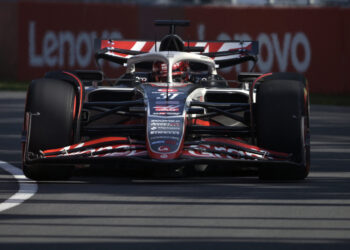The Qatar Grand Prix paddock buzzed this week with discussions about General Motors’ (GM) Cadillac officially entering Formula 1 starting in 2026. The announcement marked a seismic shift for the sport, intensifying its transformation into a battlefield dominated by global car manufacturers.
The Era of Manufacturer Wars
Alpine CEO Laurent Rossi encapsulated the sentiment, noting that F1 is evolving into a “battle of giants,” with only Williams and Alpine remaining independent of full manufacturer ownership or partnerships.
“Even Haas is also linked to a car manufacturer now… It’s another sign that the sport is going towards the direction of a battle of giants,” said Rossi, referencing Haas’ recent technical partnership with Toyota.
With Audi gearing up for a 2026 debut through Sauber, Aston Martin securing Honda as its power unit supplier, and Red Bull teaming up with Ford for its 2026 engine project, F1’s grid is shifting toward dominance by powerhouse automakers.
Cadillac’s Path: Ambition Meets Monumental Challenges
While Cadillac’s entry has been met with enthusiasm, Aston Martin team boss Mike Krack cautioned that the American automaker faces a “monumental task” to align itself with F1’s demanding 2026 regulations. This includes building a power unit independently from 2028, a tall order for any new entrant.
The $450-million anti-dilution fee, intended to offset the financial impact of adding new teams, has also drawn scrutiny. Williams’ boss James Vowles clarified that this figure remains unconfirmed and is part of the ongoing negotiations for the 2026 Concorde Agreement.
From Andretti to Cadillac: A Key Shift
The move away from Andretti Global’s earlier bid, which faced resistance and was ultimately rejected in January, has added intrigue to Cadillac’s entry. Critics argue the underlying proposition remains largely the same, with GM rebranding its involvement and removing Michael Andretti as its figurehead.
However, many insiders believe the entry’s serious financial backing and commitment to fielding a competitive team were instrumental in gaining F1’s approval. Vowles acknowledged this distinction:
“There’s a serious commitment and amount of investment going behind it. It isn’t the same proposition that was there before.”
Some speculate the shift also followed pressure from a U.S. House of Representatives investigation into alleged anticompetitive practices by F1’s commercial rights holders, Liberty Media.
Drivers Embrace Expansion
F1 drivers welcomed the news of a 22-car grid, which would be the largest field in decades. Charles Leclerc expressed his excitement about the opportunity this expansion provides for emerging talent:
“It’s the first time in my career that there’ll be 22 on the grid in F1, and that’s exciting. That will obviously give more opportunities to very talented young drivers.”
Veteran racer Fernando Alonso, who has experience with many F1 teams, voiced confidence in Cadillac’s potential, citing their recruitment of seasoned personnel, including former Renault staff:
“A new team is never an easy task, but I think they will be well prepared and they have the right people. So, yeah, welcome.”
A Welcome Shake-Up
Cadillac’s arrival signals a new chapter for Formula 1, one that could further energize its growing U.S. fanbase. Yet, as Rossi’s “battle of giants” remark suggests, the increasing dominance of manufacturers raises questions about the future of independent teams like Alpine and Williams.
Whether Cadillac can rise to the challenge remains to be seen, but its presence underscores the high stakes and relentless evolution of Formula 1 as it hurtles toward 2026.










